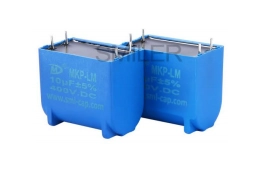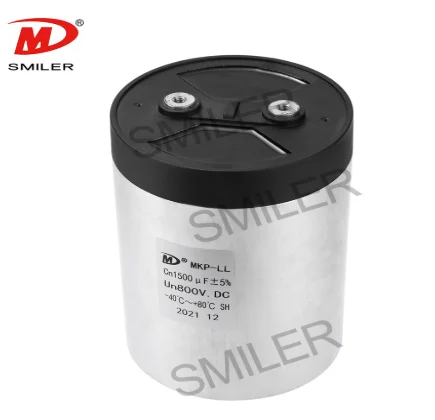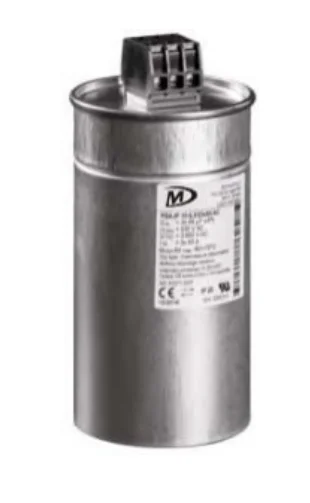 Bus capacitors are super key for electric vehicle (EV) inverters. They keep the bus voltage steady. They smooth out voltage ups and downs. This keeps the inverter working right. The inverter turns the battery's DC power into AC power for the motor. Without a good bus capacitor, voltage swings can mess things up. They might lower efficiency. They could even break the inverter or other parts. Bus capacitors also act like an energy stash. They store power and release it when needed. This handles quick power spikes or drops. It keeps things running smoothly under different loads. Old-school setups used cylindrical capacitors with laminated busbars and power modules. Those were pricey, bulky, and had high inductance. Newer designs are smaller. They fit better in modern EV systems.
Bus capacitors are super key for electric vehicle (EV) inverters. They keep the bus voltage steady. They smooth out voltage ups and downs. This keeps the inverter working right. The inverter turns the battery's DC power into AC power for the motor. Without a good bus capacitor, voltage swings can mess things up. They might lower efficiency. They could even break the inverter or other parts. Bus capacitors also act like an energy stash. They store power and release it when needed. This handles quick power spikes or drops. It keeps things running smoothly under different loads. Old-school setups used cylindrical capacitors with laminated busbars and power modules. Those were pricey, bulky, and had high inductance. Newer designs are smaller. They fit better in modern EV systems.
Picking the right bus capacitor is a big deal for keeping things steady and efficient. A bad capacitor might cause too much voltage wiggle. It might not handle fast-switching currents well. Stray inductance can make voltage jumpy at the capacitor's ends. This messes with how the circuit runs. It can hurt performance. It might even shorten part of life. A top-notch capacitor cuts energy waste with low equivalent series resistance (ESR). It also keeps stray inductance (ESL) low. These are must-haves for high-power EV setups. For example, low-ESL bus capacitors use short current paths and smart terminal designs. Narrower film width means shorter paths. That cuts inductance. These tweaks make capacitors boost system reliability big time.
Choosing a bus capacitor means checking three main things: voltage, capacitance, and ripple current.
l Voltage Rating: The rated voltage needs to be higher than your system's max voltage. This stops breakdowns during big loads. The rated voltage sets the max test voltage.
l Capacitance: This decides how much charge the capacitor holds. Bigger systems need more capacitance for higher energy needs. Capacitor capacitance: 320µF–500µF (picked based on controller power).
l Ripple Current Handling: Ripple currents come from fast switching in electronics. The capacitor must handle these without getting too hot or wearing out.
Getting these right makes sure your capacitor fits your system's needs.
 To match your inverter's needs, think about its working conditions. Look at temperature range, load changes, and space limits. For example:
To match your inverter's needs, think about its working conditions. Look at temperature range, load changes, and space limits. For example:
Temperature Tolerance: Some jobs need capacitors that stay strong in extreme heat or cold. Capacitor limit tests check high temperature (115°C) and high voltage (400VDC).
Compact Design: EVs need small parts to save space. Module capacitors use integrated packaging for a tiny size. This makes them fit tight spots.
Check electrical specs like ESR and ESL too. This helps you pick the best capacitor for your setup.
You've got two main capacitor types for EVs: film and electrolytic.
l Film Capacitors: These use metalized polypropylene film. They've got low ESR. They handle heat well. They're great for high-frequency jobs. Made by winding metalized polypropylene film, they have low loss and long life.
l Electrolytic Capacitors: These pack more capacitance in less space. But they have higher ESR. They don't do as well in high-frequency or super-hot conditions.
Film capacitors are tougher and better for EV demands.
Film tech rocks for high-performance EVs. Here's why:
l Durability: Film capacitors last ages. They self-heal from electrical stress damage. Features include high reliability and self-healing ability.
l Thermal Performance: They stay steady even in hot conditions. Capacitors keep great performance after running at 115°C.
l Low Inductance Design: Smart manufacturing keeps ESL low. Stray inductance as low as 5nH helps energy move smoothly.
Film capacitors make EV systems tougher against hard conditions.
SMILER makes a bunch of awesome bus capacitors for EV inverters. They're built to keep the voltage steady and energy flowing smoothly. They cut voltage swings. They protect key parts from power jumps. SMILER uses top-notch manufacturing and cool materials. Their capacitors fit high-performance EV needs. Their lineup has metalized polypropylene film capacitors. These are super tough with low ESR and ESL. Capacitor capacity goes from 1µF to 3000µF. Rated voltages range from 800VDC to 3000VDC. This works for everything from small cars to big commercial EVs.
SMILER's bus capacitors have neat features that make them stand out:
l Metallized Polypropylene Film: This gives great heat handling and self-healing. Made by winding metalized polypropylene film, they have low loss and long life.
l Low Stray Inductance: Smart terminal designs and tight packaging keep ESL low. Stray inductance as low as 5nH means smooth energy transfer. This cuts voltage spikes.
l High Ripple Current Handling: They take big ripple currents without overheating. This keeps performance steady for ages.
l Safety: Flame-retardant materials add protection. Internal potting with resin filling (UL94 V-0) stops fire risks.
These make SMILER's capacitors a top pick for reliable EV setups.

SMILER's bus capacitors bring big wins for EV inverters:
lSteady Systems: They smooth voltage swings. This keeps inverters and parts running right. Bus capacitors help smooth voltage fluctuations by storing and releasing electric energy.
lMore Efficient: Low ESR and ESL cut energy waste during power changes. Low loss and low internal temperature rise make inverters work better.
lSpace Savers: Small designs fit tight EV spaces. Module capacitors use integrated packaging for a tiny size.
lHeat Tough: They stay strong in hot conditions. Capacitors keep great performance at 115°C.
lLong Life: Self-healing means less maintenance. Features include high reliability and self-healing ability.
These perks make SMILER's capacitors key for solid, efficient EV systems.
Q: What role does a bus capacitor play in an EV inverter?
A: It keeps bus voltage steady. It cuts fluctuations. It acts as an energy stash for sudden power changes.
Q: How do I pick the right capacitance for my EV inverter?
A: Match it to your system's power needs. Bigger systems need more. Capacitor capacitance: 320µF–500µF (picked by controller power).
Q: What materials are used in top bus capacitors?
A: Metallized polypropylene film is common. It's got great heat handling, low ESR/ESL, and self-healing.
Q: Why is stray inductance a big deal when picking a bus capacitor?
A: High stray inductance causes voltage wiggles or buzzing. This hurts circuits.
Q: How does film tech boost capacitor performance?
A: Film capacitors have low ESR/ESL, great heat handling, self-healing, and long life.